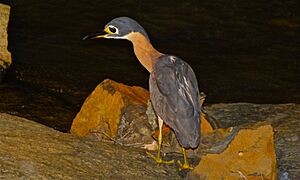White-backed night heron facts for kids
Quick facts for kids White-backed night heron |
|
|---|---|
 |
|
| Conservation status | |
| Scientific classification | |
| Genus: |
Calherodius
|
| Species: |
leuconotus
|
| Synonyms | |
|
|
The white-backed night heron (Calherodius leuconotus) is a special type of bird. It's a medium-sized heron that lives in sub-Saharan Africa. This area is south of the Sahara Desert.
Naming the Heron
A German scientist named Johann Wagler first described this bird in 1827. He called it Ardea leuconotus. Today, bird experts place it in its own unique group, called a monotypic genus. This means it's the only species in that group.
The heron's name comes from a white patch on its back. This patch looks like a triangle. It helps people easily identify this bird.
What Does It Look Like?
The white-backed night heron is about 50 to 55 centimeters (20 to 22 inches) long. It has a black head and a short, fancy group of feathers on top of its head. This is called a crest.
Its eyes are large and red. They have white rings around them. The skin area behind its eyes, called the lore, is a light yellow color. The feathers on its throat are white. Its neck and chest are a reddish-brown color, which is called rufous.
You can see a clear white triangle on its back. This shape is made by small white feathers on its shoulders. These are called scapulars. The feathers on its belly are a whitish-brown. Its legs are yellow.
Young herons look a bit different. They have streaky chests. They also have white spots on the top of their wings. Baby herons are covered in soft, olive-brown down.
Where Does It Live?
The white-backed night heron lives across central and southern Africa. Its home covers a very large area. This area is estimated to be about 20.9 million square kilometers (8 million square miles).
It mostly lives in thick forests near water. You can find it near streams, lakes, mangroves, and marshes. These wet, green places are perfect for it.
Life and Habits
White-backed night herons can be found alone or in pairs. They are active at night, which means they are nocturnal. During the day, they rest in the thick plants of marshes and forests. They often sleep high up in trees.
Their nests are usually well-hidden. They build them near water, sometimes in reedbeds, mangroves, rocks, or caves. The nest looks like a flat platform made of sticks or reeds. It is about 25 to 30 centimeters (10 to 12 inches) wide.
They usually lay eggs during the rainy season. Sometimes they breed early in the dry season. A female heron lays two or three greenish-white eggs. The eggs hatch after about 24 to 26 days. The young birds leave the nest when they are about six to seven weeks old.
These herons usually stay in one place. This is called being sedentary. However, sometimes they move to areas with heavy rain. White-backed night herons search for food along waterways. They eat fish, amphibians, mollusks, and insects. They are usually quiet. But if they are scared, they make a loud kroak sound. If someone disturbs them, they make a taash call.
Is It Safe?
The number of white-backed night herons seems to be steady. They are not facing big drops in their population. They also don't have many major threats. Because of this, the IUCN Red List says they are a species of "least concern." This means they are not in danger right now.
However, there are a few small threats. In southern Africa, they are losing some of their natural homes. In Nigeria, some are hunted for traditional medicine.


